What is Granite?

Granite is an igneous rock. This means it forms from the cooling and solidification of magma deep within the Earth’s crust. This process, often spanning millions of years, allows for the slow crystallization of its primary minerals – quartz, alkali feldspar, and plagioclase. These minerals give granite its signature coarse-grained (phaneritic) texture, where individual crystals are visible to the naked eye.
The appearance of granite can vary widely, with colors ranging from pink to gray, depending on its mineral composition. The pink hues are typically due to the presence of potassium-rich feldspar, while the gray tones come from the quartz and feldspar balance. Intriguingly, granite often contains trace amounts of other minerals, such as mica or amphibole, adding to its unique pattern and depth.
Granite is also important economically. One of granite’s most celebrated characteristics is its robustness. This strength stems from its interlocking mineral grains, which provide immense durability. This attribute, combined with its aesthetic appeal, has made granite a favored material in various architectural and sculptural applications throughout human history. But let’s start with geology.
Formation and Composition of Granite
The formation of granite begins with magma generated deep in the Earth’s mantle or lower crust. This magma is typically rich in silica and alkali metals, which also define granite’s chemical composition. As the magma rises towards the Earth’s surface, it starts cooling slowly. This gradual cooling is crucial, as it allows time for the large, identifiable crystals of quartz, feldspar, and other minerals, to form.
Granite is primarily found in two geological settings. The first is in continental crust, where it forms massive plutonic bodies known as batholiths. These batholiths are often the cores of mountains and can cover hundreds of square kilometers. The second common setting is in smaller intrusions like dikes, sills, and stocks. These are essentially offshoots of the main magma body that were injected into cracks and spaces in the surrounding rock.
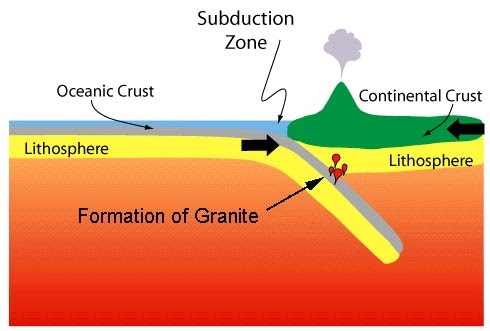
As the magma cools, different minerals crystallize at different temperatures, a process known as fractional crystallization. This leads to the diverse mineral compositions found in various granites and contributes to the wide array of colors and textures that we see in granite rocks.
Types of Granite
Granite encompasses a diverse group of rocks. We say “granite” like it’s one thing, but they can look very different from one another. The broader family of granitic rocks, or granitoids, describes a range of compositions and textures. One key distinction within this family is between true granite and other granitoid varieties. True granite is rich in both quartz and alkali feldspar. However, rocks with less quartz are classified differently. They’re called syenites or monzonites.
Leucogranites are a notable type within the granitic family. These rocks are characterized by their light color, due to the minimal presence of dark minerals like mica or amphibole. The prefix “Leuco” means white — like in leukocyte (white blood cell). Conversely, granites with a higher content of these dark minerals present a more mottled, darker appearance.
The textural variety within granites is also noteworthy. Some granites display a porphyritic texture, where large crystals known as phenocrysts are embedded in a finer-grained matrix. This occurs when certain minerals crystallize before the rest of the magma. These larger crystals offer a glimpse into the early stages of the granite’s cooling history.
In general, however, granites are classified
Biotite Granite
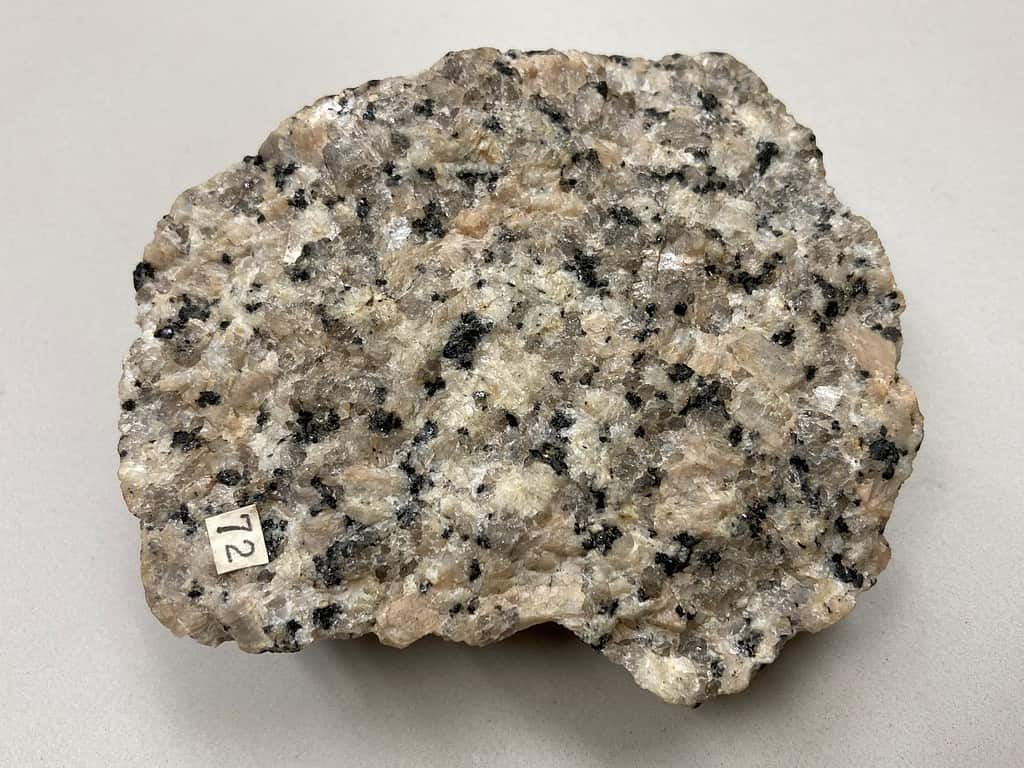
Biotite granite is rich in biotite mica, which gives it a dark color, often in shades of brown or black. This variety is known for its striking appearance and is frequently used in architectural elements where a bold contrast is desired.
Hornblende Granite
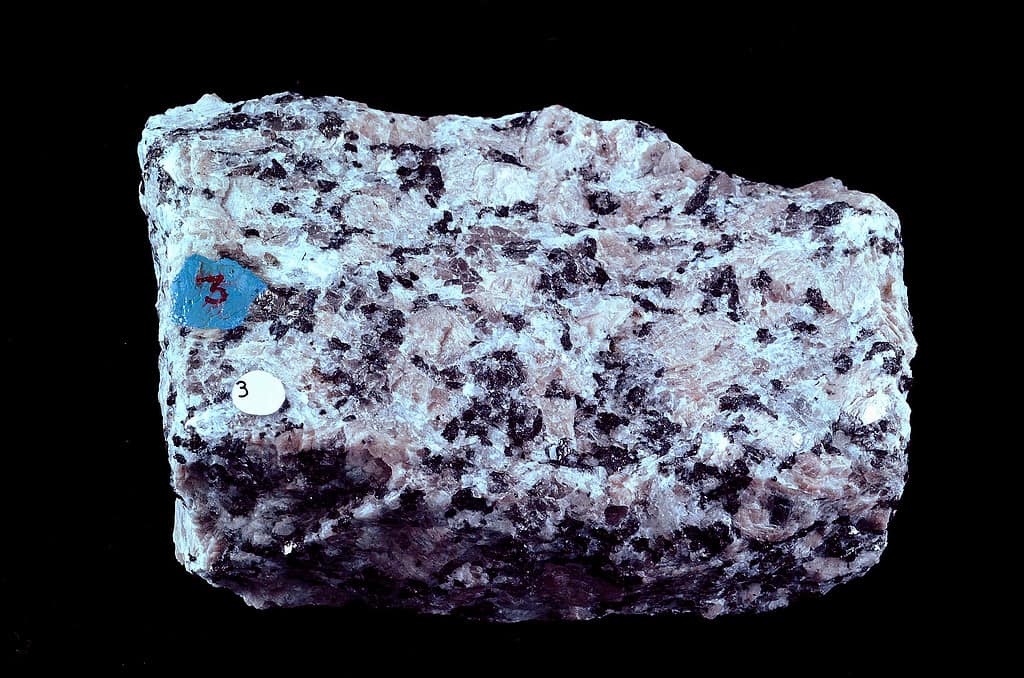
Hornblende granite contains significant amounts of hornblende, a dark, green to black amphibole mineral. This type of granite typically has a speckled appearance and is prized for its subtle yet sophisticated look.
Pink Granite
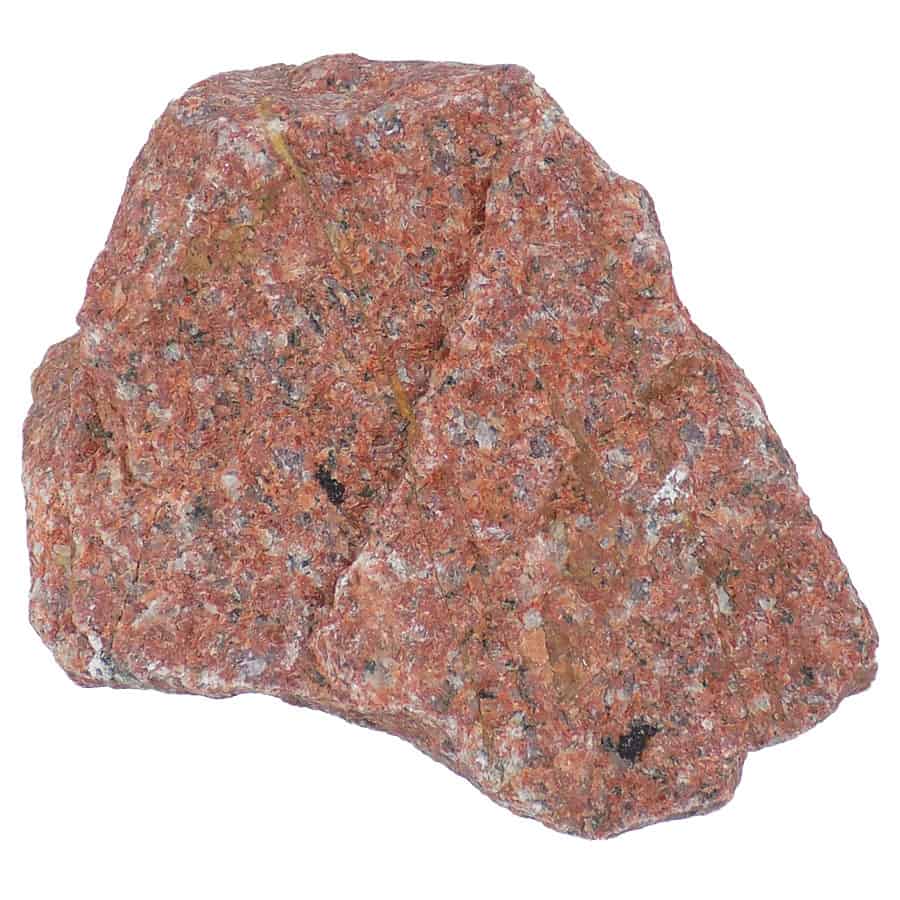
Rich in potassium feldspar, pink granite is known for its warm, inviting hue. This variety is a popular choice in interior design and for decorative purposes, bringing a natural, yet refined, aesthetic to spaces.
White Granite
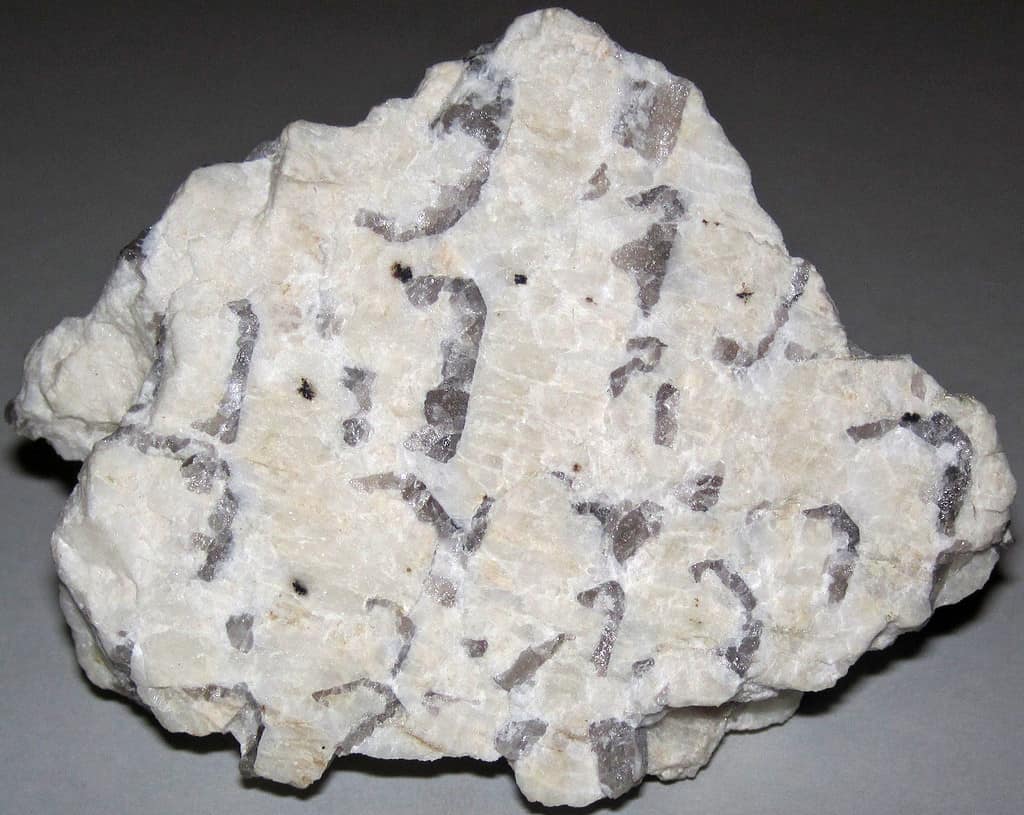
White granite, containing lesser amounts of dark minerals and more quartz and feldspar, offers a clean and contemporary look. It is widely used in modern design schemes, particularly for countertops and flooring.
Black Granite
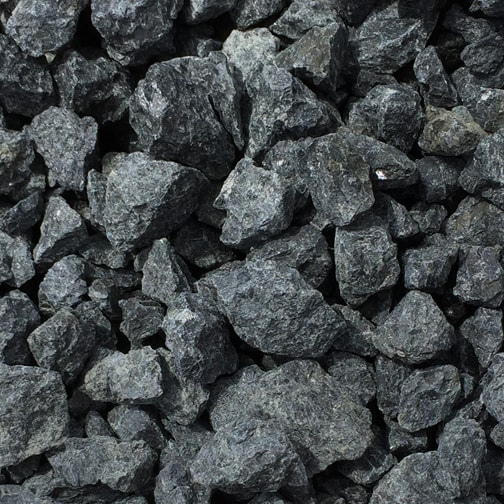
Often used as a generic term for various dark-colored igneous rocks, true black granite doesn’t really exist. What people people call black granite (especially in industrial or decorative settings) is an igneous type of rock called gabbro or monzonite. Other dark igneous rocks like diorite or anorthosite are also sometimes referred to as “black granite” but this is not a geological term.
Classification of Granite
If you’ve ever tried to classify an igneous rock, you’ve probably seen one of these diagrams.
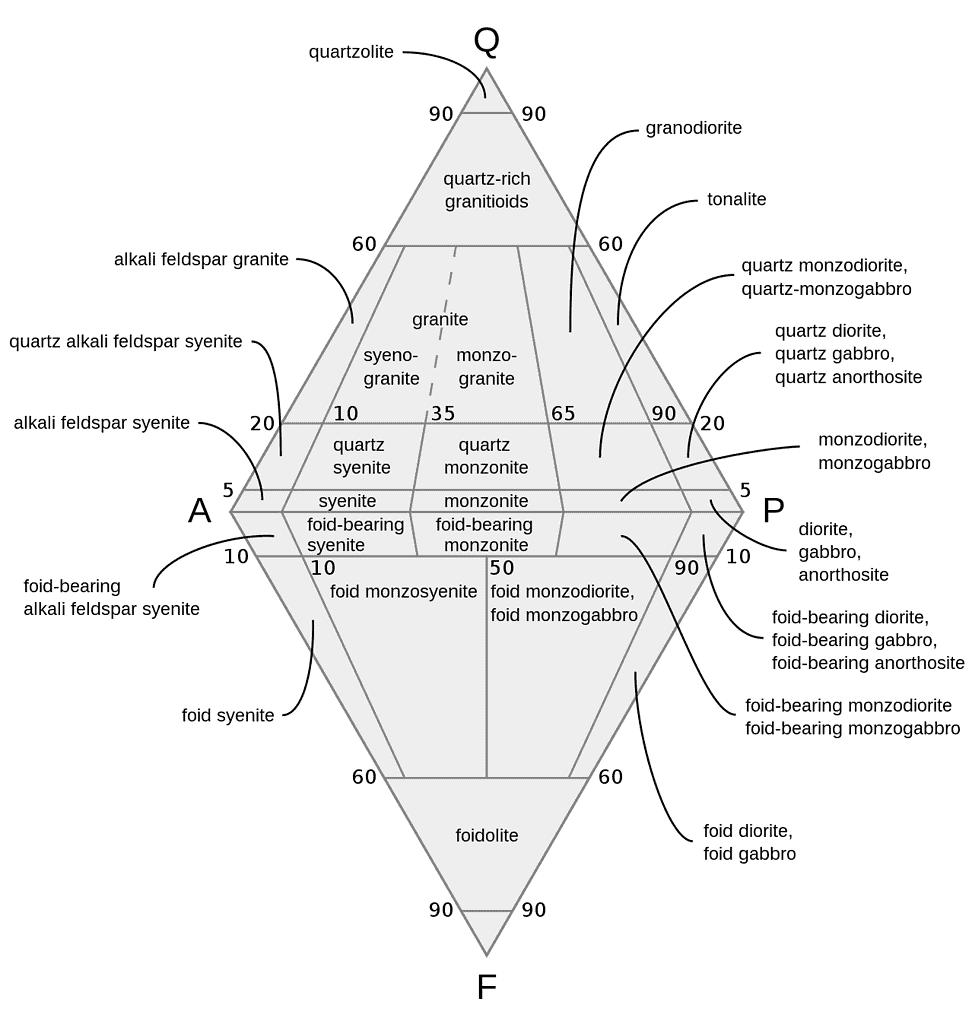
Geologists commonly classify granite using the QAPF diagram. This classification tool uses the relative proportions of quartz (Q), alkali feldspar (A), and plagioclase (P) to categorize granitic rocks. Although they seem complex, they’re actually pretty simple to use. You ignore the dark minerals like biotite, amphibole, and pyroxene, and then you estimate the content of the remaining rock.
In rarer cases, some rocks don’t have quartz and they have a different type of minerals instead called a feldspathoid (F). This is where the QAPF diagram comes from. This diagram isn’t used just for granites, it’s used for most igneous rocks.
True granite, in the strict petrological sense, contains 20-60% quartz by volume, and 35-90% of its total feldspar content is alkali feldspar.
Granitic rocks with less quartz are categorized differently. For instance, syenites and monzonites, which have lower quartz content, and granodiorites or tonalites, which are dominated by plagioclase.
A unique category within this classification is alkali feldspar granites, with over 90% alkali feldspar.
The classification of granite can also be performed by variations in mineral composition and source. For example, I-type (Igneous source) granites are rich in sodium and calcium, while S-type (Sedimentary sources) granites are more aluminum-rich and often contain micas like muscovite instead of amphibole.
Characteristics of Granite
Physical Properties
- Durability and Hardness: Granite is renowned for its hardness and durability, owing to the interlocking crystal structure formed during the slow cooling of magma. This makes it resistant to scratches and wear, ideal for surfaces that endure regular use.
- Texture and Grain Size: The phaneritic texture of granite, characterized by grains visible to the naked eye, is a hallmark of its slow crystalline formation. The size and arrangement of these grains can vary, giving each granite piece a unique appearance.
- Color Variations: The color of granite can range from pink to gray, depending on its mineral composition. Quartz typically imparts a gray or white color, while feldspar adds pink, orange, or blue hues. The presence of other minerals like mica can introduce black or green shades.
- Density and Porosity: Granite typically has a density between 2.65 and 2.75 g/cm³. It is relatively less porous compared to other stones, contributing to its strength and resistance to weathering.
- Chemical Resistance: Granite is generally resistant to acids and alkalis, making it suitable for various installations where chemical exposure is possible.
- Thermal Stability: Its high melting point and ability to withstand temperature variations make granite an excellent material for high-temperature applications.
- Radiation: Natural granite contains trace amounts of radioactive elements like uranium, which can emit radon gas, albeit typically at very low, safe levels.
Chemical Properties
Granite’s chemical properties are primarily determined by its mineral composition, predominantly quartz, alkali feldspar, and plagioclase. These minerals contribute to the overall chemical characteristics of granite, making it a unique and versatile rock. Here are key chemical properties:
- Silica Content (SiO2): Granite has a high silica content, typically ranging from 65% to 75%. This high silica content is largely due to the abundance of quartz, a major constituent of granite.
- Alumina (Al2O3): Alumina, usually in the form of aluminum oxide, constitutes about 10-15% of granite’s composition. It’s primarily sourced from feldspar minerals in the granite.
- Alkali Metals: Granite contains significant amounts of alkali metals, particularly potassium (K2O) and sodium (Na2O), which generally range between 3-8%. These elements are derived from alkali feldspar minerals like orthoclase and microcline.
- Calcium Oxide (CaO): Though less abundant than silica and alumina, calcium oxide is still a notable component of granite, usually around 1-2%. It mainly comes from the plagioclase feldspar.
- Minor Components: Granite may contain trace amounts of other oxides like iron oxide (FeO, Fe2O3), magnesium oxide (MgO), titanium dioxide (TiO2), phosphorus pentoxide (P2O5), and manganese oxide (MnO). These contribute to the minor variations in color and physical properties of different granite types.
- Acid Resistance: Due to its high silica content and the lack of easily carbonated minerals, granite is quite resistant to weathering by acids. This makes it a durable material in environments exposed to acid rain or acidic pollutants.
- Radioactive Elements: Granite often contains trace amounts of radioactive elements like uranium, thorium, and potassium-40. The concentration of these elements can vary, but they are typically low and not harmful in most applications.
How to Identify Granite
Identifying granite involves examining several key features that differentiate it from other rock types. These features are observable both in the field and through more detailed geological analysis.
- Visual Inspection: Granite’s coarse-grained texture, where individual crystals of quartz, feldspar, and mica are visible, is a primary identification marker. The presence of large feldspar crystals, often pink or white, is a strong indicator of granite.
- Color and Pattern: Examining the color and pattern can provide clues to its identification. A mix of white, pink, and black grains is a typical granite appearance.
- Hardness Test: Granite is harder than most common materials, including steel. It can scratch glass and will resist scratching from a steel knife blade.
- Acid Test: Unlike limestone and marble, granite does not react with acidic solutions. This can be a quick field test to differentiate between these common rock types.
- Density and Weight: Granite feels heavier than it looks due to its density. This can be a subtle but useful clue in identifying it.
Common Uses of Granite
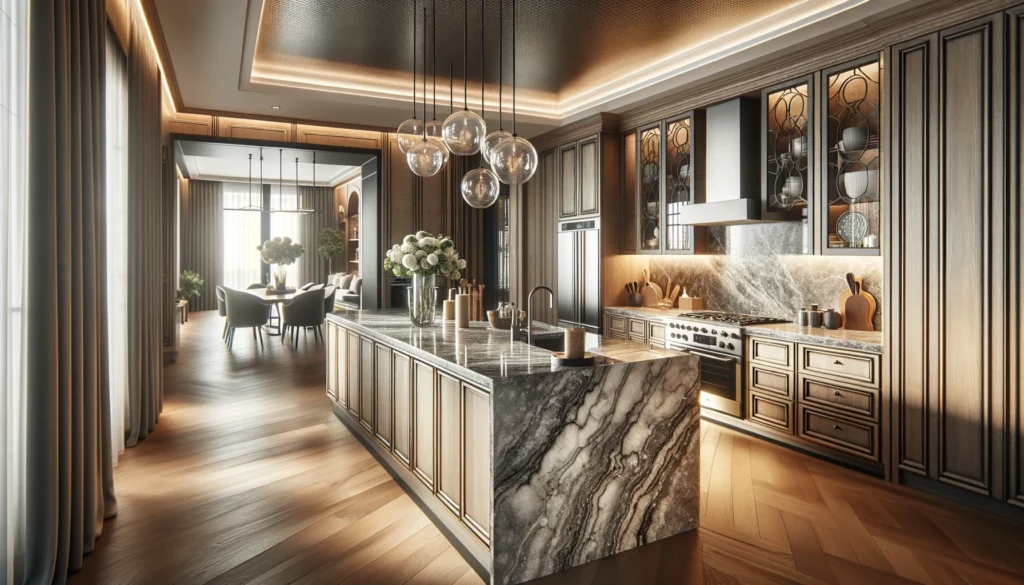
Granite’s legacy in human use is as old as civilization itself. Historically, its durability made it a material of choice for monuments and buildings. Ancient Egyptians, for instance, used granite extensively in pyramids and temples. In modern times, granite’s applications have become even more diverse.
In construction, granite is used for both structural and decorative purposes. Its resistance to weathering and abrasion makes it ideal for exterior cladding, flooring, and as a paving material. The aesthetic appeal of granite, with its rich colors and intricate patterns, has made it a popular choice for countertops, tiles, and ornamental features.
Artistically, granite has been a favored medium for sculptors due to its hardness and ability to hold fine detail. This tradition continues today, with granite being a preferred material for public monuments and sculptures.
Granite also finds applications in engineering contexts. Its dimensional stability and hardness make it suitable for use in precision instruments, such as surface plates, and as a base for machinery.

Conclusion
In conclusion, granite is more than a mere rock; it’s a symbol of geological wonders and human ingenuity. From its slow crystallization beneath the Earth’s surface to its diverse uses in architecture, art, and engineering, granite tells a story of time, transformation, and utility. Its variety, durability, and beauty not only make it a material of choice in various fields but also a subject of fascination in geology. Whether in the form of imposing mountain ranges or intricately carved sculptures, granite continues to be an integral part of our natural and cultural landscapes.






